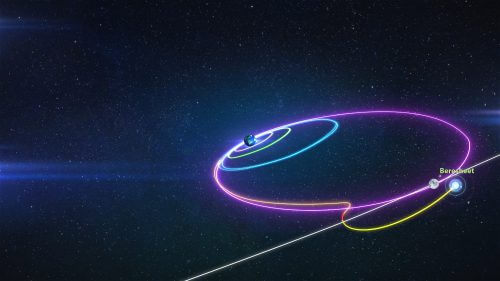The success of the maneuver, after which the spacecraft is supposed to circle the moon every two hours, will determine the fate of the historic step - the landing of an Israeli spacecraft on the moon. The maneuver will take place tomorrow, Thursday at 17:15 pm

The engineering team of SpaceIL and the Aerospace Industry will tomorrow (Thursday) perform the most decisive maneuver so far in the spacecraft's journey to the moon - "capturing the moon". The maneuver will allow the spacecraft to be captured by the moon's gravity and thus begin to circle it and with it the Earth.
So far, the spacecraft has circled the Earth in elliptical orbits, during which several maneuvers (starting engines) were performed in order to raise its orbit and move it away from the Earth. At the beginning of the week, the spacecraft reached for the last time the closest point to the ball in Israel in the last lap around it - only 1,700 km and from there it continued on its way to the meeting point with the moon at a range of 400 thousand km.
Unlike maneuvers carried out so far - in which engines were activated in order to accelerate the speed of the spacecraft, now the engines will be activated to slow down the speed of the Genesis and allow the moon to capture it. The spacecraft will be slowed down from a speed of 8,500 km/h to a speed of 7,500 km/h relative to the moon.
If the deceleration is not carried out properly, the spacecraft may escape from the gravitational force of the Earth and the Moon and enter another unwanted orbit around the Sun, thus ending the mission.
The success of the maneuver will put the spacecraft into an elliptical orbit around the moon where the closest point (Perilona) is about 500 km from the moon and the farthest point (Apollona) is about 10,000 km. In the week after the capture, several maneuvers will be performed to reduce the orbits around the moon from an elliptical orbit to a circular orbit at a height of 200 km above the moon. Unlike the long orbits around the Earth, the first orbits around the moon will last about 14 hours and towards the landing the entire orbit around the moon will last only about two hours.
The purpose of the maneuvers after the capture of the moon is to lower altitude and reach the optimal point for the autonomous landing of the spacecraft in the "calm sea" on 11/4 in the evening.
Interim summary - the journey of "Genesis" until the capture of the moon:
So far, 7 maneuvers have been performed, the spacecraft has covered approximately 5.5 million km cumulatively in all its orbits and is expected to travel another million km in orbits around the moon. A total of 12.5 orbits around the earth were performed (7 orbits at an altitude of 70,000 km, 2 orbits at an altitude of 131,000 km, 2 orbits at an altitude of 265,000 km and 1.5 orbits at an altitude of 410,000 km). The amount of fuel used so far is about 80 kg.
A total of two main faults were recorded which the engineering team overcame, one in the satellites which were dazzled by the sun more than what was observed and the other unwanted reboots in the mission computer.
As a reminder, on February 22nd at 03:45 the Israeli spacecraft Bereshit was successfully launched to the moon from Cape Canaveral, Florida in the USA on top of a SpaceX launch pad using a Falcon 9 rocket as a secondary payload alongside two satellites. At 04:23 the first data from Berashit began to be received and at 04:25 the legs of the spacecraft were deployed as planned. In doing so, Israel made history by launching the first ever Israeli spacecraft into space.
